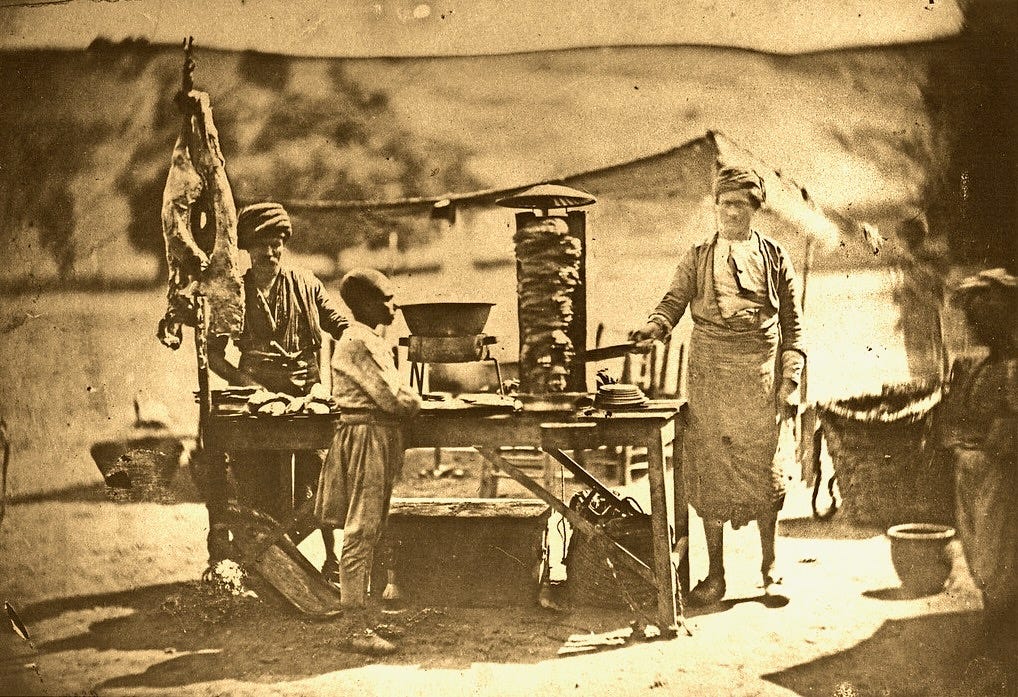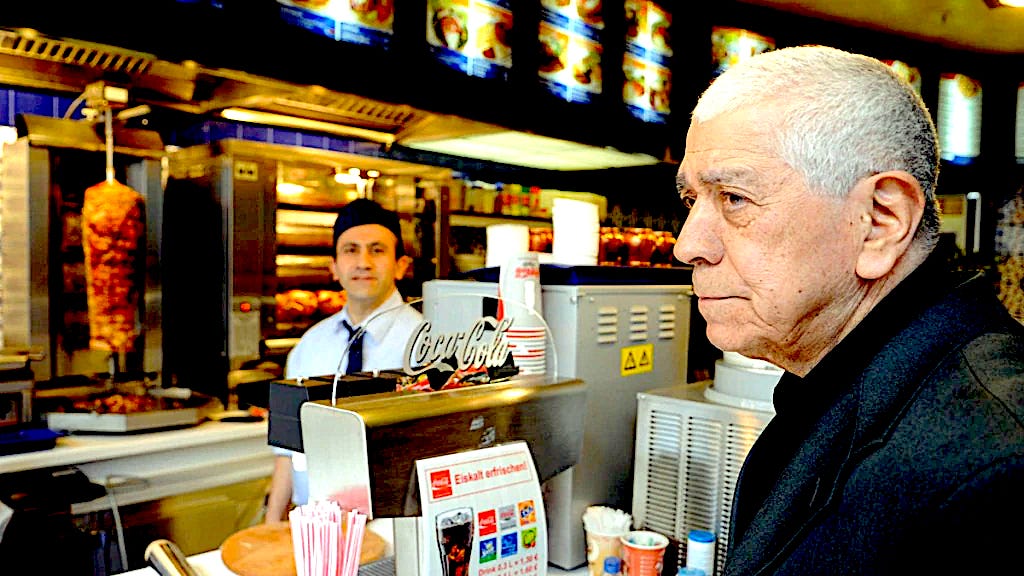Welcome to the latest installment of Notable Sandwiches, the feature where I, alongside my stalwart editor David Swanson, nibble my way through Wikipedia’s List of Notable Sandwiches in alphabetical order. This week: a Turkish-German favorite, the doner kebab.
Kebab is an old, old word.
It’s been formally attested to as far back as the 10th century, in an ancient compendium entitled The Book of Dishes, a Baghdadi cookbook by Ibn Sayar al-Warraq that gathered some 600 recipes, an amalgam of the culinary heritage of Persia, Mesopotamia, and the Levant. The author defined kebab as “meat cut into pieces, skewered and grilled on open fire”—a fair approximation of the way it’s used today. But like many ancient words and dishes, kebab has acquired a legion of adaptations, cognates, variants, offshoots and reinventions, shifting and adapting for millennia, along with the peoples that have made it.
So Albanians and Macedonians feud over the relative merits of Ćevapi and Kebapi, Pakistanis and Bangladeshis snack on shami, seekh, bihari and chapli kebabs; Iranians feast on saffron-scented Joojeh kabab on Nowruz and other celebrations. (Wikipedia has a List of Kebabs in direct analogue to its List of Sandwiches, arguably a more toothsome alternative to this project.) Some of these consist of ground meat, others add considerable fillings, still others offer shaved meat in lieu of the butchered and skewered pieces al-Warraq specified in the 10th century. The only things these variations have in common are meat and flame, two constants that have held humanity together since time immemorial.
The people with the widest variety—and, arguably, the strongest national claim—on the kebab as a dish are the Turks, who serve up their flame-kissed meaty treats on tomato-soaked bread in the wonderful iskender kebab, the sizzling three-ingredient Adana kebabı, yogurt-topped Beyti kebap, and the West-conquering shish kebab, of backyard-BBQ fame. There are variants all along the Bosphorus, the Aegean Sea, and the Dardanelles, and across the lunar landscape of Cappadocia. This article is dedicated to none of the above.
Instead, in a piquant proof of the way kebabs have traveled and adapted alongside their creators, the kebab we are here to discuss was born in Germany. The doner, a street-food staple for boozed-up Berliners, exploded across Germany’s urban landscape in the decades after World War II, when Turks began to immigrate en masse to the cities of West Germany.
The doner has more in common with the shaved-meat school of kebab-adjacent foods—like gyros and shawarma, both of which will get their own sandwich essays in due time—than with the shish kebab. Usually served in sturdy, seed-studded Turkish bread, the meat is carved from revolving inverted cones of lamb, beef, pork, or chicken, sliced expertly, adorned with an array of toppings—vegetables, condiments, possibly even fries—and served throughout Germany, where it’s become an official food of barflies, club kids, and soccer fans. It’s delicious, in the way that hot, fatty protein encased in stout starch and adorned with spice and garlic always is.
The Sword and the Sandwich is a newsletter about serious extremism and equally serious sandwiches. Please consider supporting this work with a paid subscription:
Some foods—like, say, sole meunière, any form of soufflé, or any cut of beef with the word “Wagyu” in it—demand hushed cadences, white tablecloths and rapt attention. The doner kebab is, by contrast, messy and unassuming, an embellishment to events rather than their sole focus. It’s a night food, a crowd food, a street food, one that practically demands raucousness instead of politesse. And as such, it’s become as ubiquitous in Germany as the Turks that make it.
According to various estimates over the last decade, there are between three and seven million individuals of Turkish descent residing in Germany (the variance here is largely due to the nation’s vagueness on questions of ethnicity in its census, along with the dueling estimates of academics who all seem to use different criteria to determine who counts as a Turk). Most of these communities consist of immigrants from Turkey itself and their descendants, but other individuals of Turkish ethnicity have migrated from the Balkans, including Greece, Macedonia, and Bulgaria, encompassing a broad swathe of kebab variants in the process.
This exodus began in 1961, when an economically thriving postwar West Germany signed a treaty with Turkey to import hundreds of thousands of guest workers, thus filling its labor shortage and driving its industrial boom. Even as collapsing oil prices introduced economic recession in the 1970s, new family reunification policies ensured that the Turkish community in Germany kept growing, putting down roots and changing the face of the nation in the process.
It was during the ‘70s that the doner kebab as we know it was invented, at least according to the story officially endorsed in 2013 by the Berlin-based Association of Turkish Doner Manufacturers in Europe. In 1972, a Turkish immigrant named Kadir Nurman, who had a kebab stall in West Berlin, began selling his shaved meat and vegetal toppings in a pillow of Turkish flatbread, enabling the busy and boozy to eat on the go. As with any major world sandwich, there are a number of competing tales of the doner’s genesis—a prior claimant, Mahmut Aygun, was eulogized as the inventor when he passed in 2009, having slipped the surly bonds of earth almost forty years after purportedly slipping meat into a Berlin-baked pita in 1971.
Still, other observers have noted that vertically-roasted meat was well attested to throughout the Ottoman empire for centuries (see the photo at the top of the page); that shaved meat in flatbread has long existed throughout the Middle East; and that, therefore, placing the invention of the doner in any specific early-’70s kebab stall in Berlin is a foolish fancy. As mentioned ad nauseam in this series, when it comes to sandwich invention there is no shortage of putative mothers, and short of flying to Berlin myself, learning both German and Turkish, and eating my way through a large swathe of the city’s doner shops, it’s very difficult to sort through the validity of these claims. (If any of you want to pay for this as a business trip, my soul is ready, if not my stomach. nor indeed my kidneys.)
Since the 1970s, according to the Migration Policy Institute, Turkish immigration to Germany has changed in character several times. Refugees driven out by a military coup in the ‘80s encountered hostility, xenophobia, and official obstacles to assimilation; in the late 1980s, German repatriation incentives inspired some quarter-million immigrants to return to Turkey; the 1990s saw the Turkish-Kurdish conflict and another wave of refugees. In the 21st century, German-Turkish migration patterns have been “circular,” with immigrants coming and going according to season, employment opportunities, educational attainment, and other factors. And the sandwich has marched on, relentlessly, spawning some 16,000 doner shops across Germany. According to at least one poll, it’s now more popular than currywurst.
The German-branded doner has even crossed oceans: New York Magazine’s Tammie Teclemariam recently reported on the grand opening of a franchise literally called German Doner Kebab in Astoria, Queens; she judged its product inferior to two other German-style doner shops, Kotti Berliner in Downtown Brooklyn and Berlin Doner in Greenwich Village. A Turkish treat made famous in Berlin and airlifted to New York might seem a smidgen bewildering. But the kebab—or kabab, kebob, kebap, cevap, et alius—has always moved and mutated like the fire that makes it, picking up capsicum in Turkey and cinnamon in Morocco, yogurt sauce and ajvar in the Balkans, dried pomegranate seeds in Peshawar, and grease and fame in Germany along the way. The only thing the kebab needs—and this it will never lack—is hungry mouths to crave it, and flame to sear it into being.










After a concert -- or even a long night in the pub -- in '80s England, you could pretty much guarantee at least one doner kebab van nearby, to get a hot, greasy snack before heading home!
Fast forward to a few years ago, now living in California, I went to see Morrissey in San Jose and came out to several doner kebab carts (and hot dog carts)... who all seemed bewildered that none of the concert-goers were buying their meaty wares... they clearly didn't get Morrissey's memo that "Meat is Murder" (which he hammers home at all of his concerts to a mostly vegan audience, it seems).